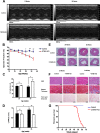Stromal interaction molecule 1 is essential for normal cardiac homeostasis through modulation of ER and mitochondrial function
- PMID: 24585777
- PMCID: PMC3989749
- DOI: 10.1152/ajpheart.00075.2014
Stromal interaction molecule 1 is essential for normal cardiac homeostasis through modulation of ER and mitochondrial function
Abstract
The endoplasmic reticulum (ER) Ca(2+) sensor stromal interaction molecule 1 (STIM1) has been implicated as a key mediator of store-dependent and store-independent Ca(2+) entry pathways and maintenance of ER structure. STIM1 is present in embryonic, neonatal, and adult cardiomyocytes and has been strongly implicated in hypertrophic signaling; however, the physiological role of STIM1 in the adult heart remains unknown. We, therefore, developed a novel cardiomyocyte-restricted STIM1 knockout ((cr)STIM1-KO) mouse. In cardiomyocytes isolated from (cr)STIM1-KO mice, STIM1 expression was reduced by ∼92% with no change in the expression of related store-operated Ca(2+) entry proteins, STIM2, and Orai1. Immunoblot analyses revealed that (cr)STIM1-KO hearts exhibited increased ER stress from 12 wk, as indicated by increased levels of the transcription factor C/EBP homologous protein (CHOP), one of the terminal markers of ER stress. Transmission electron microscopy revealed ER dilatation, mitochondrial disorganization, and increased numbers of smaller mitochondria in (cr)STIM1-KO hearts, which was associated with increased mitochondrial fission. Using serial echocardiography and histological analyses, we observed a progressive decline in cardiac function in (cr)STIM1-KO mice, starting at 20 wk of age, which was associated with marked left ventricular dilatation by 36 wk. In addition, we observed the presence of an inflammatory infiltrate and evidence of cardiac fibrosis from 20 wk in (cr)STIM1-KO mice, which progressively worsened by 36 wk. These data demonstrate for the first time that STIM1 plays an essential role in normal cardiac function in the adult heart, which may be important for the regulation of ER and mitochondrial function.
Keywords: ER stress; STIM1; cardiomyocytes; mitochondria; store-operated Ca2+ entry.
Figures




References
-
- Bers DM. Calcium cycling and signaling in cardiac myocytes. Annu Rev Physiol 70: 23–49, 2008 - PubMed
-
- Bravo R, Vicencio JM, Parra V, Troncoso R, Munoz JP, Bui M, Quiroga C, Rodriguez AE, Verdejo HE, Ferreira J, Iglewski M, Chiong M, Simmen T, Zorzano A, Hill JA, Rothermel BA, Szabadkai G, Lavandero S. Increased ER-mitochondrial coupling promotes mitochondrial respiration and bioenergetics during early phases of ER stress. J Cell Sci 124: 2143–2152, 2011 - PMC - PubMed
-
- Buerger A, Rozhitskaya O, Sherwood MC, Dorfman AL, Bisping E, Abel ED, Pu WT, Izumo S, Jay PY. Dilated cardiomyopathy resulting from high-level myocardial expression of Cre-recombinase. J Card Fail 12: 392–398, 2006 - PubMed
Publication types
MeSH terms
Substances
Grants and funding
LinkOut - more resources
Full Text Sources
Other Literature Sources
Molecular Biology Databases
Research Materials
Miscellaneous

